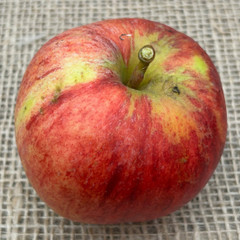Description
Large flat, round fruit, greenish yellow with slight red flush. Cooks well, gives plenty of juice, which can be used as an 'acid carrier' for blending in cider. A vigorous grower with thick, spreading branches. This best known of all cooking apples does have some snags: Apart from its size, the flowers are very sensitive to frost, and being a Triploid, it is not a pollinator of other apples and needs a pollinator to ensure cropping. It was raised between 1809 and 1813 by Miss Mary Anne Brailsford in her garden at Church Street, Southwell. Her cottage, along with the tree, passed to a Mr Bramley a local butcher, and Henry Merryweather offered the tree for sale.
"The finest of all culinary apples in England, the most planted, the heaviest cropper, the best cooker, and the easiest to sell. So says Taylor of this most famous of apples, whose iron-clad constitution has assured its popularity since first introduced in 1865 by Merryweather & Son, of Southwell Nottinghamshire. Very excellent, says the Backhouse catalogue; 'growing wherever apples will grow' says Bunyard. It is the example that every pomologist will cite as the most happy chance seedling. It is perhaps still the most widely grown apple in commercial orchards, with year-round availability, and is found in almost every home garden and orchard.
It was raised from a pip by Miss Mary Ann Brailsford, of Southwell, Nottinghamshire, some time between 1809-13, in a garden in Church Street. It achieved local fame there, leading the astute Henry Merryweather to seek scions from one Mr Matthew Bramley, (Bunyard credits him with its raising) from the tree in the garden of the cottage, which Bramley had bought in 1846. Thereby is Matthew Bramley's name immortalised, and lent since to Southwell's community centre, community newspaper, and the public house on Church Street, The Bramley Apple.
All praise is due to the Bramley in many respects; it can be made to cook to a creamy, brisk-flavoured purée, or it can be more slowly baked to preserve its form; it can be used in all manners of tarts and pies; in savoury dishes its flavour proves robust and is not overwhelmed by spices. It can be made into a single-fruit juice, or used to lend sharpness to blended juices (at 16mg/100g, it is very rich in vitamin C); and it will make a full sharp cider. It is rich in malic acid, and it is this that sustains its sharp apple flavour even after cooking.
The shop-bought product win not match your own, however, for the production line has not the luxury of allowing it to develop its full flavour in storage; by the time it has sweetened and mellowed in your own fruit store, you will find it a good crisp eater with a brisk sweet-sharp bite. If it can be faulted, it is that the store-bought apple is often a little lacking in flamboyance, and for the connoisseur, its virtues have perhaps been obscured with overfamiliarity. Unfair. Home-grown fruits will commonly have more colour, and in the north often more so than the south." - © Lin Hawthorne - 'The Northern Pomona'.
For help with choosing the correct rootstock for your needs, please click here A Guide to Rootstocks
For help with choosing the correct size and shape, please click here A Guide to Fruit Tree Shapes







